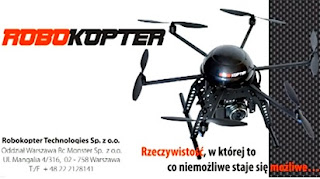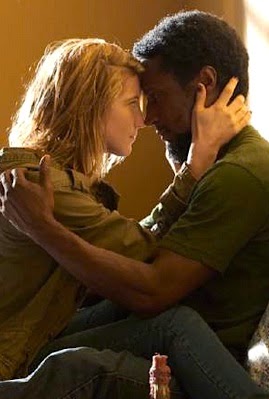Release the drones:
A future of journalism
We might have seen this coming sooner or later in our era of too much information and not enough.
After years of our being digitally observed at every stage of modern life (from the camera at the convenience store down the block to the one embedded in your bank ATM); after the Predator gun-camera images of combat in Iraq and Afghanistan have made their way onto the evening news; after cities like New York and London have developed nonstop citywide surveillance that would give George Orwell pause; after downsized video cameras and the ubiquity of YouTube have made everyone a potential documentarian … the future may have got here for journalism, one that’s got the potential to be a game-changer for how we get the news.
This possible future has been arriving in fits and starts in recent months, more about which later. But it arrived, in a kind of a global maiden voyage, on Nov. 11, at the Independence Day protests in Warsaw. Police were mobilized to perform crowd control at the event, a combustible mix of ardent Polish nationalists and left-wing anarchists gathered to mark the anniversary of the birth of Poland as an independent state in 1918.
As police moved toward the site, people in the vicinity heard a loud buzzing sound overhead — the sound of a small helicopter carrying a video camera — a drone — recording a compelling overhead view of the chaos on the ground. The drone, built by RoboKopter Technologies Sp., swooped and zoomed over the protest site for several minutes, a noisy little bastard, buzzing the crowd like a Briggs & Stratton dragonfly.
The event was widely reported in Polish media and elsewhere around the world.
And this apparently wasn’t the first time. Back in May, CNN producer Aaron Brodie used a Parrot AR.Drone, made by a French manufacturer, to record storm damage near Tuscaloosa, Ala. The French quadricopter, who reportedly costs about $300, is controllable with an iPad or iPhone.
“It’s a bit challenging to fly, but when you get the hang of it you can get some nice aerial footage out of it,” Brodie told CNN’s Brett Roegiers. Brodie reportedly added a GoPro HD camera to the drone. Result? A newsgathering predator created for the relatively low cost of $550.
““This is really at the low end of what’s possible,” he reported. “There’s much more sophisticated drone technology out there that is now available to really anybody, including us in the news media, and I think this is going to continue to provide a whole new perspective on things.”
And News Corporation has been using drones in some of its reporting — given News Corp’s current troubles concerning surveillance of citizens, we shouldn’t be surprised — and even brags about it through “The Daily Drone,” a feature in News Corp’s iPad-only tabloid publication, The Daily.
Drone journalism raises the prospect for a new conflict between government and the media over access to information and application of the First Amendment.
On Nov. 17, for example, The New York Times reported that despite the often startlingly clear quality of the images over Warsaw, “it is unlikely that the New York Police Department, which closed the airspace above Lower Manhattan during Tuesday’s raid, would have taken kindly to a flock of drone journalists.”
But since when does the NYPD, or any other entity, control and monitor the tools by which journalists do their work?
This is what makes drone journalism such a potential game-changer for journalism. As the current Occupy protests around the country gain momentum, police departments in numerous cities have grappled with how to respond. In New York, police recently tried to control information on crowd control the old-fashioned way: by not letting the media in in the first place.
The advent of drone journalism could change this, in a hurry.
It’s true that any use of drone technology for newsgathering in the United States would have to grapple with regulations by the Federal Aviation Administration, which pretty much governs anything (except military aircraft) that flies in airspace above the United States.
In 1987, the FAA published Advisory Circular 91-57, Model Aircraft Operating Standards, a regulation that sets guidelines for drone use for civilian and commercial purposes. Right now, hobbyists can fly drones at altitudes of no more than 400 feet.
“The FAA recognizes that people and companies other than modelers might be flying [unmanned aircraft systems] with the mistaken understanding that they are legally operating,” the agency said in a media notice underscoring the fact that AC 91-57 “specifically excludes [drone] use by persons or companies for business purposes.”
In an Aug. 2 e-mail, FAA spokesman Les Dorr told Forbes the agency was “examining The Daily’s use of a small unmanned aircraft to see if it was in accordance with FAA policies.”
◊ ◊ ◊
All that legal nomenclature just barely obscures questions of authority and precedent, questions sure to come up as drone technology evolves and reaches beyond the hobbyist market to include frequent use by news organizations.
In the midst of a breaking news event of obvious interest to a cross-section of Americans, which is controlling — Advisory Circular 91-57 or the First Amendment to the Constitution?
Why should news organizations be under any more obligation to report use of drones in newsgathering than they’re required to report the number of notebooks, tape recorders and other tools used by reporters to do their jobs?
Where’s the line drawn between drones for “business purposes,” which the FAA forbids, and drones for gathering the news, something the agency doesn’t specifically address?
Will the FAA entertain requests from news orgs for exemption from current regulations, on the basis of a constitutionally-protected right of journalists to report the news — and by extension, the public’s right to know?
◊ ◊ ◊
There’s clearly potential for abuse. The fact that News Corp (still navigating a scandal over telephone hacking of celebrities and private citizens) is at or near the forefront of this developing trend is proof of that. And you can imagine what madness the paparazzi might unleash with this (“Who’s that with Ashton Kutcher leaving the Ivy? Give me tighter scale on that, please…”).
But there’s clearly as much or more potential for drone journalism to put skeptical, professional eyes on a news event when it’s not possible to put boots on the ground where that event is happening. Drones could be used in place of reporters and videographers physically going into hazardous regions to get footage, saving lives and money in the process.
And in this role, its highest, best civic purpose, drones would be used to shed light in places where officialdom would often prefer the darkness — the same kind of informational darkness the New York City Police Department sought to invoke when it banned the media from the most recent eviction of Occupiers from Zuccotti Park.
Sometimes the future shows up on cat’s feet, sometimes with an explosion heard round the world. The future for breaking-news journalism may have arrived in the form of a annoying, buzzing aerial contraption that goes where breaking-news journalists sometimes can’t, and where American aviation law has never really been before.
Image credits: RoboKopter promotional, Warsaw police mobilizing: ©2011 RoboKopter Technologies, via YouTube. Independence Day street view: RoboKopter via ITN News. Logos are properties of their parent companies.






.jpg)
Comments
Post a Comment